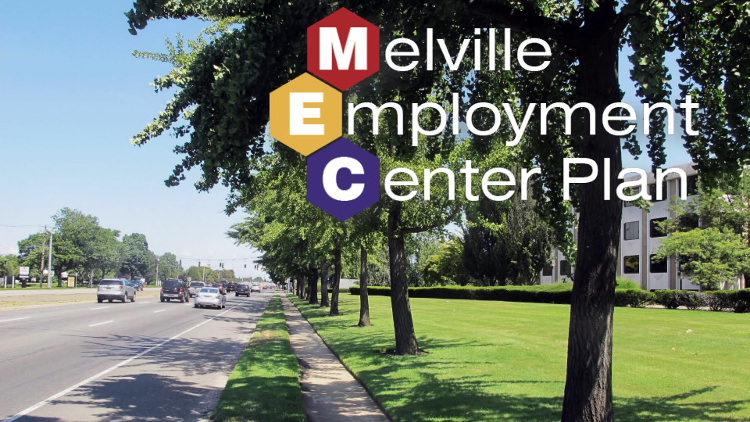When it comes to the future of Long Island, residents should ditch the NIMBY attitudes and be constructively open-minded—but only if their local government promises to be responsive to the legitimate needs of the community.
That’s the challenge facing the Town of Huntington as it contemplates what to do with the Route 110 Corridor on the Suffolk and Nassau border. The outcome looms large for Melville, one of the biggest employment hubs on the Island, whose economic vitality depends upon the integration of transit service, a balance of residential and commercial space and an innovative mixed-use development.
Earlier this month, BFJ Planning, Urbanomics and Parsons Brinckerhoff, a team of consultants that the town had hired on the recommendation of its Melville Plan Advisory Committee, hosted a public workshop concerning the Melville Employment Center, the designation of a key commercial concentration on the Island in western Suffolk County that is Huntington’s largest source of employment and tax revenue. Resident turnout was strong, as were their views regarding the future of their community. I also spoke, trying to ease some concerns while raising these issues. The meeting was the first of what the town has said may be a year-long process before coming up with a draft plan.
The Route 110 Corridor is often defined as “Long Island’s economic spine” thanks to an abundance of corporate headquarters that include multinational giants like Canon USA, Nikon and Henry Schein. The area also contains the largest undeveloped tracts of land in the Town of Huntington, which—for better or worse—presents an opportunity for Melville to transform itself. After initial review, BFJ found that the unincorporated hamlet’s “traditional suburban office development has led to traffic congestion and a lack of pedestrian amenities.”
BFJ also observed that due to Melville’s large building footprints surrounded by ample parking lots, the aesthetic visual impacts aren’t exactly stellar. Workers in the area have complained about their relative isolation, the lack of walkability and the availability of few amenities. Residents have complained about the traffic, the congestion and the ever-increasing cost of living, a regional issue felt on the local level.
Melville’s engaging in the planning process couldn’t come at a better time. As the New York State Department of Transportation wraps up expanding Route 110’s capacity to handle the multiple peak periods of traffic in the area, proposals have been made for implementing a new bus-rapid-transit (BRT) lane and reopening the Republic Airport LIRR Station, closed since 1986.
No matter the approach, big questions—as always—must be answered. Are the consultants contemplating shoehorning more residents into this relatively isolated hamlet? Can the area handle increases in density without direct access to public transit? And, just as importantly, will LI’s affluent corporate workers even want to use it?
Before moving forward, it’s critically important that BFJ and the town conduct a destination/origin study to see where, exactly, these Melville workers are coming from, and whether or not transit can meet their commuting needs.
Proposals for providing sewage capacity and area-wide storm management should be explored seriously, but expect large costs of implementation and large impacts on the aquifer. The last Melville Industrial Sewer District Feasibility Study is now more than 20 years old. The area is also home to West Hills County Park, an underutilized public asset that is a geologically sensitive Special Groundwater Protection Area. Because of Melville’s mid-Island location, any sewage treatment plant would have to be a package plant that discharges its effluent into the aquifer unless funding can be found for other solutions.
Planners and policymakers must embrace the current economic realities that the area faces. Is it wise to recommend growth to accommodate a new BRT route and LIRR station at Republic Airport if neither is built yet? Does the MTA even have the capital funding earmarked for the reopening of the Republic Airport station? These questions have to be answered before any plan is even drafted, because they will help dictate substantive policy and land use recommendations for the Town of Huntington to take.
If neither a new BRT route or a reopened LIRR station is realistic, the plan should be scaled down and focused on providing amenities for local residents and the large population of workers in the area. Are there chokepoints in the street network where the town could ease the congestion? Can the office parks be made pedestrian friendly, complete with social civic spaces and more attractive streetscapes? These improvements have been shown to bolster residential property values elsewhere, so Melville residents should welcome them with open arms.
Further commercial and office development should be halted along the Route 110 Corridor until there is coordination among projects like Jerry Wolkoff’s massive Heartland Town Square, Syosset Park, Renaissance Downtown’s efforts in Huntington Station and myriad other mixed-use proposals that are cropping up.
All of this is well and good, but any plan is driven by resident input and scientific data. Local government and the consultants are responsible for an honest analysis of the area’s needs. They must answer the questions raised here before making any policy recommendations. The replies cannot be predetermined, and the assessments must not be driven by stakeholders.
What was concerning was that at the public meeting there was talk of an advisory committee that was comprised of all too familiar players in the Island’s development scene. The committee should be expanded to include more civic leaders and local residents – the same old stakeholders lead to the same old solutions.
The residents have an even bigger responsibility, for they must accept the findings and help implement the plan. What is key is an open-minded, constructive attitude that leaves room for change in the community. Clearly, Melville’s physical layout no longer serves the needs of those who live in the hamlet—and those who work there.
Rampant NIMBYism against sensible fixes like providing sidewalks, attractive lighting and more retail options shouldn’t be protested reflexively. Instead, local residents should focus on getting traffic flow improved, and on reducing conflicts of land use between their residential neighborhoods and their neighboring offices and industrial properties.
Let’s work to make Melville a shining example that local planning on the Island can benefit the entire region. The process has to be driven constructively by data and by input from residents and stakeholders having an honest conversation of the area’s needs.
Without this effort, the Melville Employment Center Plan will be worthless.
Rich Murdocco writes about Long Island’s land use and real estate development issues. He received his Master’s in Public Policy at Stony Brook University, where he studied regional planning under Dr. Lee Koppelman, Long Island’s veteran master planner. Murdocco is a regular contributor to the Long Island Press. More of his views can be found on www.TheFoggiestIdea.org or follow him on Twitter @TheFoggiestIdea.































